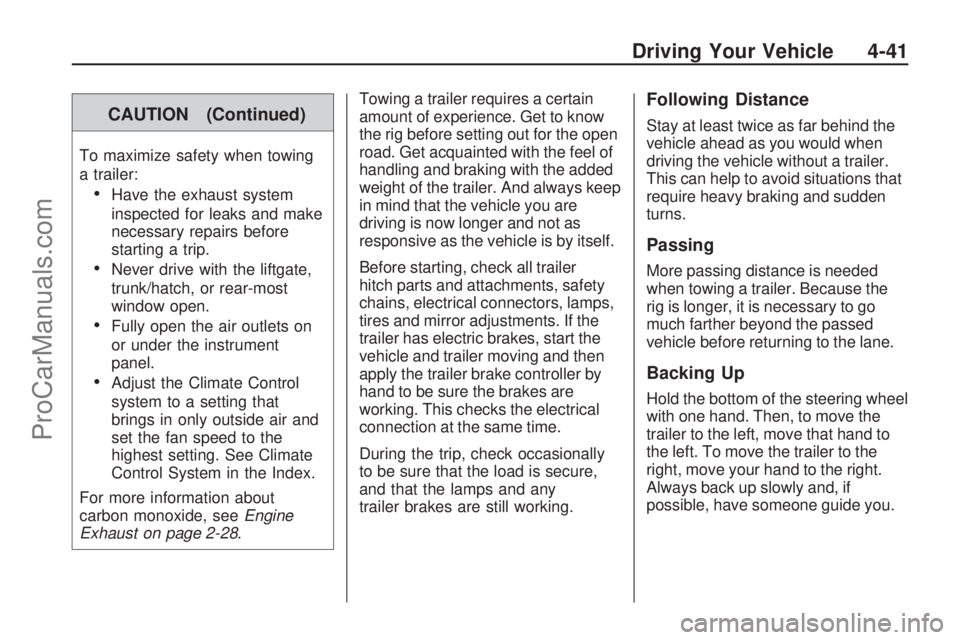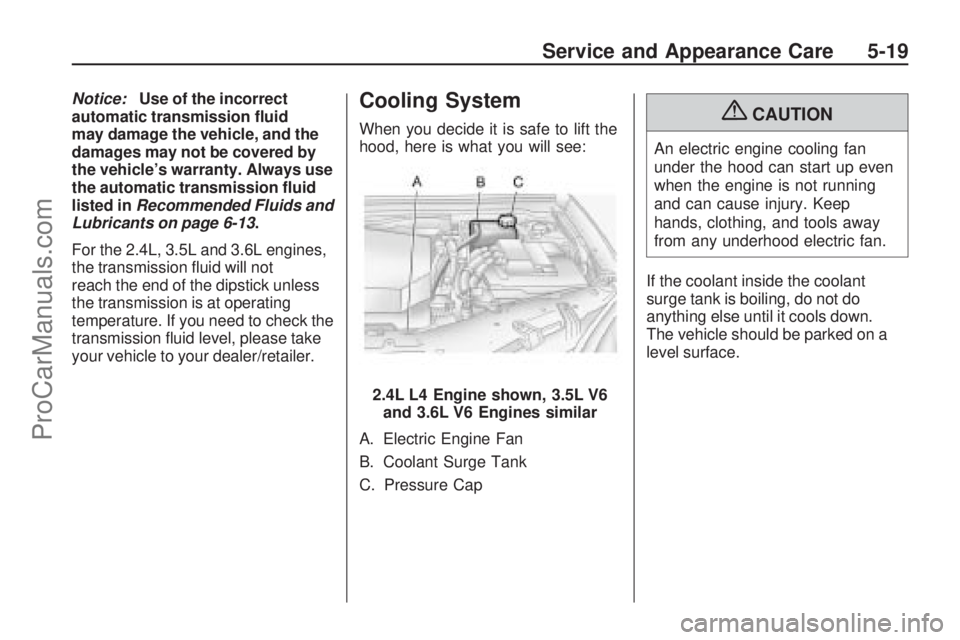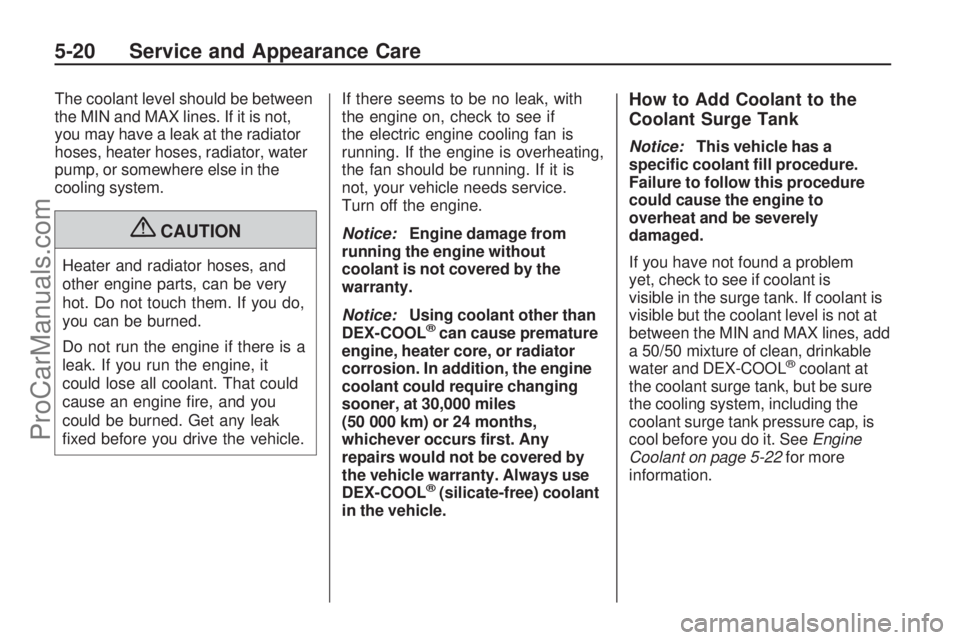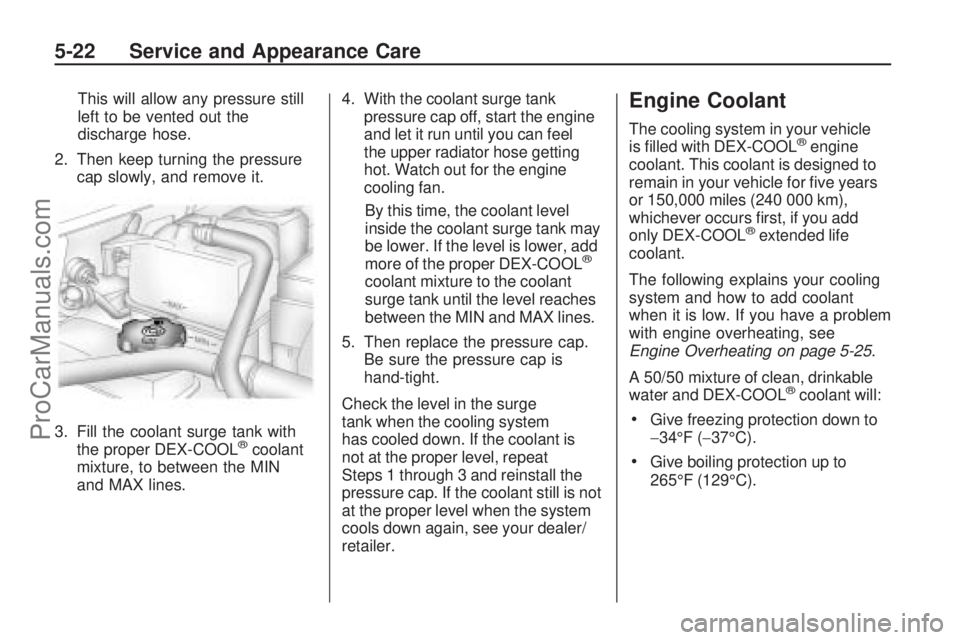fan SATURN VUE 2009 Owner's Manual
[x] Cancel search | Manufacturer: SATURN, Model Year: 2009, Model line: VUE, Model: SATURN VUE 2009Pages: 386, PDF Size: 2.3 MB
Page 230 of 386

Blizzard Conditions
Being stuck in snow can be in a
serious situation. Stay with the
vehicle unless there is help nearby.
If possible, use theRoadside
Assistance Program on page 7-6.
To get help and keep everyone
in the vehicle safe:
Turn on theHazard Warning
Flashers on page 3-5.
Tie a red cloth to an outside
mirror.
{CAUTION
Snow can trap engine exhaust
under the vehicle. This may cause
exhaust gases to get inside.
Engine exhaust contains carbon
monoxide (CO) which cannot be
seen or smelled. It can cause
unconsciousness and even death.
(Continued)
CAUTION (Continued)
If the vehicle is stuck in the snow:
Clear away snow from
around the base of your
vehicle, especially any that is
blocking the exhaust pipe.
Check again from time to
time to be sure snow does
not collect there.
Open a window about
two inches (5 cm) on the side
of the vehicle that is away
from the wind to bring in
fresh air.
Fully open the air outlets on or
under the instrument panel.
Adjust the Climate Control
system to a setting that
circulates the air inside the
vehicle and set the fan speed
to the highest setting. See
Climate Control System in the
Index.
(Continued)
CAUTION (Continued)
For more information about
carbon monoxide, seeEngine
Exhaust on page 2-28.
Snow can trap exhaust gases
under your vehicle. This can
cause deadly CO (carbon
monoxide) gas to get inside. CO
could overcome you and kill you.
You cannot see it or smell it, so
you might not know it is in your
vehicle. Clear away snow from
around the base of your vehicle,
especially any that is blocking the
exhaust.
Run the engine for short periods
only as needed to keep warm,
but be careful.
To save fuel, run the engine for
only short periods as needed
to warm the vehicle and then shut
the engine off and close the window
most of the way to save heat.
4-26 Driving Your Vehicle
ProCarManuals.com
Page 245 of 386

CAUTION (Continued)
To maximize safety when towing
a trailer:
Have the exhaust system
inspected for leaks and make
necessary repairs before
starting a trip.
Never drive with the liftgate,
trunk/hatch, or rear-most
window open.
Fully open the air outlets on
or under the instrument
panel.
Adjust the Climate Control
system to a setting that
brings in only outside air and
set the fan speed to the
highest setting. See Climate
Control System in the Index.
For more information about
carbon monoxide, seeEngine
Exhaust on page 2-28.Towing a trailer requires a certain
amount of experience. Get to know
the rig before setting out for the open
road. Get acquainted with the feel of
handling and braking with the added
weight of the trailer. And always keep
in mind that the vehicle you are
driving is now longer and not as
responsive as the vehicle is by itself.
Before starting, check all trailer
hitch parts and attachments, safety
chains, electrical connectors, lamps,
tires and mirror adjustments. If the
trailer has electric brakes, start the
vehicle and trailer moving and then
apply the trailer brake controller by
hand to be sure the brakes are
working. This checks the electrical
connection at the same time.
During the trip, check occasionally
to be sure that the load is secure,
and that the lamps and any
trailer brakes are still working.
Following Distance
Stay at least twice as far behind the
vehicle ahead as you would when
driving the vehicle without a trailer.
This can help to avoid situations that
require heavy braking and sudden
turns.
Passing
More passing distance is needed
when towing a trailer. Because the
rig is longer, it is necessary to go
much farther beyond the passed
vehicle before returning to the lane.
Backing Up
Hold the bottom of the steering wheel
with one hand. Then, to move the
trailer to the left, move that hand to
the left. To move the trailer to the
right, move your hand to the right.
Always back up slowly and, if
possible, have someone guide you.
Driving Your Vehicle 4-41
ProCarManuals.com
Page 258 of 386

Filling a Portable Fuel
Container
{CAUTION
Never �ll a portable fuel container
while it is in the vehicle. Static
electricity discharge from the
container can ignite the fuel vapor.
You can be badly burned and the
vehicle damaged if this occurs. To
help avoid injury to you and others:
Dispense fuel only into
approved containers.
Do not �ll a container while it
is inside a vehicle, in a
vehicle’s trunk, pickup bed, or
on any surface other than the
ground.
(Continued)
CAUTION (Continued)
Bring the �ll nozzle in contact
with the inside of the �ll
opening before operating the
nozzle. Contact should be
maintained until the �lling is
complete.
Do not smoke while
pumping fuel.
Do not use a cellular phone
while pumping fuel.
Checking Things
Under the Hood
{CAUTION
An electric fan under the hood can
start up and injure you even when
the engine is not running. Keep
hands, clothing, and tools away
from any underhood electric fan.
{CAUTION
Things that burn can get on hot
engine parts and start a �re.
These include liquids like fuel, oil,
coolant, brake �uid, windshield
washer and other �uids, and
plastic or rubber. You or others
could be burned. Be careful not to
drop or spill things that will burn
onto a hot engine.
5-10 Service and Appearance Care
ProCarManuals.com
Page 260 of 386

Engine Compartment Overview
When you open the hood on the 2.4L L4 engine, you will see the following:
A. SeeEngine Air Cleaner/Filter on
page 5-17.
B. Electric Engine Cooling Fan (Out of View). See Cooling System on
page 5-19. C. Engine Oil Dipstick (Out of View).
See “Checking Engine Oil” under
Engine Oil on page 5-14 .
D. Engine Oil Fill Cap (Out of View). See “When to Add Engine Oil”
under Engine Oil on page 5-14 .E. Brake Fluid Reservoir. See
Brakes on page 5-28 .
F. Engine Coolant Surge Tank. See “Checking Coolant” under Engine
Coolant on page 5-22 .
G. Remote Positive (+) Terminal. See Jump Starting on page 5-31 .
H. See Underhood Fuse Block
on page 5-82.
I. See Battery on page 5-30 .
J. Windshield Washer Fluid Reservoir. See “Adding Washer
Fluid” under Windshield
Washer Fluid on page 5-27 .
5-12 Service and Appearance Care
ProCarManuals.com
Page 261 of 386

When you open the hood on the 3.5L V6 engine (3.6L V6 similar), you will
see the following:
A. SeeEngine Air Cleaner/Filter on
page 5-17.
B. Power Steering Fluid Reservoir (Out of View). See Power
Steering Fluid on page 5-26 .C. Electric Engine Cooling Fan (Out
of View). See Cooling System
on page 5-19.
D. Engine Oil Fill Cap. See “When to Add Engine Oil” under Engine
Oil on page 5-14. E. Engine Oil Dipstick (Out of View).
See “Checking Engine Oil” under
Engine Oil on page 5-14.
F. Automatic Transmission Fluid Dipstick (Out of View). See
“Checking the Fluid Level” under
Automatic Transmission Fluid
on page 5-18.
G. Brake Fluid Reservoir (Out of View). See Brakes on page 5-28 .
H. Engine Coolant Recovery Tank. See Cooling System on
page 5-19.
I. Remote Positive (+) Terminal. See Jump Starting on page 5-31 .
J. See Underhood Fuse Block
on page 5-82.
K. See Battery on page 5-30 .
L. Windshield Washer Fluid Reservoir. See “Adding Washer
Fluid” under Windshield
Washer Fluid on page 5-27 .
Service and Appearance Care 5-13
ProCarManuals.com
Page 267 of 386

Notice:Use of the incorrect
automatic transmission �uid
may damage the vehicle, and the
damages may not be covered by
the vehicle’s warranty. Always use
the automatic transmission �uid
listed inRecommended Fluids and
Lubricants on page 6-13.
For the 2.4L, 3.5L and 3.6L engines,
the transmission �uid will not
reach the end of the dipstick unless
the transmission is at operating
temperature. If you need to check the
transmission �uid level, please take
your vehicle to your dealer/retailer.Cooling System
When you decide it is safe to lift the
hood, here is what you will see:
A. Electric Engine Fan
B. Coolant Surge Tank
C. Pressure Cap{CAUTION
An electric engine cooling fan
under the hood can start up even
when the engine is not running
and can cause injury. Keep
hands, clothing, and tools away
from any underhood electric fan.
If the coolant inside the coolant
surge tank is boiling, do not do
anything else until it cools down.
The vehicle should be parked on a
level surface.
2.4L L4 Engine shown, 3.5L V6
and 3.6L V6 Engines similar
Service and Appearance Care 5-19
ProCarManuals.com
Page 268 of 386

The coolant level should be between
the MIN and MAX lines. If it is not,
you may have a leak at the radiator
hoses, heater hoses, radiator, water
pump, or somewhere else in the
cooling system.
{CAUTION
Heater and radiator hoses, and
other engine parts, can be very
hot. Do not touch them. If you do,
you can be burned.
Do not run the engine if there is a
leak. If you run the engine, it
could lose all coolant. That could
cause an engine �re, and you
could be burned. Get any leak
�xed before you drive the vehicle.If there seems to be no leak, with
the engine on, check to see if
the electric engine cooling fan is
running. If the engine is overheating,
the fan should be running. If it is
not, your vehicle needs service.
Turn off the engine.
Notice:Engine damage from
running the engine without
coolant is not covered by the
warranty.
Notice:Using coolant other than
DEX-COOL
®can cause premature
engine, heater core, or radiator
corrosion. In addition, the engine
coolant could require changing
sooner, at 30,000 miles
(50 000 km) or 24 months,
whichever occurs �rst. Any
repairs would not be covered by
the vehicle warranty. Always use
DEX-COOL
®(silicate-free) coolant
in the vehicle.
How to Add Coolant to the
Coolant Surge Tank
Notice:This vehicle has a
speci�c coolant �ll procedure.
Failure to follow this procedure
could cause the engine to
overheat and be severely
damaged.
If you have not found a problem
yet, check to see if coolant is
visible in the surge tank. If coolant is
visible but the coolant level is not at
between the MIN and MAX lines, add
a 50/50 mixture of clean, drinkable
water and DEX-COOL
®coolant at
the coolant surge tank, but be sure
the cooling system, including the
coolant surge tank pressure cap, is
cool before you do it. SeeEngine
Coolant on page 5-22for more
information.
5-20 Service and Appearance Care
ProCarManuals.com
Page 270 of 386

This will allow any pressure still
left to be vented out the
discharge hose.
2. Then keep turning the pressure
cap slowly, and remove it.
3. Fill the coolant surge tank with
the proper DEX-COOL
®coolant
mixture, to between the MIN
and MAX lines.4. With the coolant surge tank
pressure cap off, start the engine
and let it run until you can feel
the upper radiator hose getting
hot. Watch out for the engine
cooling fan.
By this time, the coolant level
inside the coolant surge tank may
be lower. If the level is lower, add
more of the proper DEX-COOL
®
coolant mixture to the coolant
surge tank until the level reaches
between the MIN and MAX lines.
5. Then replace the pressure cap.
Be sure the pressure cap is
hand-tight.
Check the level in the surge
tank when the cooling system
has cooled down. If the coolant is
not at the proper level, repeat
Steps 1 through 3 and reinstall the
pressure cap. If the coolant still is not
at the proper level when the system
cools down again, see your dealer/
retailer.
Engine Coolant
The cooling system in your vehicle
is �lled with DEX-COOL®engine
coolant. This coolant is designed to
remain in your vehicle for �ve years
or 150,000 miles (240 000 km),
whichever occurs �rst, if you add
only DEX-COOL
®extended life
coolant.
The following explains your cooling
system and how to add coolant
when it is low. If you have a problem
with engine overheating, see
Engine Overheating on page 5-25.
A 50/50 mixture of clean, drinkable
water and DEX-COOL
®coolant will:
Give freezing protection down to
−34°F (−37°C).
Give boiling protection up to
265°F (129°C).
5-22 Service and Appearance Care
ProCarManuals.com
Page 274 of 386

If you get the overheat warning with
no sign of steam, try this for a
minute or so:
1. If you have an air conditioner
and it is on, turn it off.
2. Turn on your heater to full hot at
the highest fan speed and open
the windows as necessary.
3. Try to minimize engine load. If
you are in a traffic jam, shift to
N (Neutral); otherwise, shift to the
highest gear possible while
driving.
If you no longer have the overheat
warning, you can drive. Just to
be safe, drive slower for about
ten minutes. If the warning does
not come back on, you can drive
normally.
If the warning continues and you
have not stopped, pull over, stop,
and park your vehicle right away.If there is still no sign of steam, idle
the engine for three minutes
while you are parked. If the warning
continues, turn off the engine and
get everyone out of the vehicle until
it cools down.
You may decide not to lift the hood
but to get service help right away.
Power Steering Fluid
SeeEngine Compartment Overview
on page 5-12for reservoir location.
When to Check Power
Steering Fluid
Power steering �uid is used in all
vehicles with V6 engines. Vehicles
with the 4-cylinder engine have
electric power steering and does not
use power steering �uid.
It is not necessary to regularly
check power steering �uid unless
you suspect there is a leak in
the system or you hear an unusual
noise. A �uid loss in this system
could indicate a problem. Have the
system inspected and repaired.
How to Check Power Steering
Fluid
To check the power steering �uid,
do the following:
1. Turn the key off and let the
engine compartment cool down.
2. Remove engine oil �ll cap.
3. Slide engine cover rearward and
lift to remove.
5-26 Service and Appearance Care
ProCarManuals.com
Page 280 of 386

4. Open the hood on the other
vehicle and locate the positive (+)
and negative (−) terminal
locations on that vehicle.
Open the hood on your vehicle
and �nd the remote positive (+)
and remote negative (−) jump
starting terminals.
Your vehicle is equipped with
a remote positive (+) terminal.
This is located in the engine
compartment on the driver side
of the vehicle, on the underhood
fuse block. SeeEngine
Compartment Overview on
page 5-12for more information
on location.To uncover the remote positive
(+) terminal, press the tab on the
bottom of the fuse block and
lift the cover up.
The remote negative (−) terminal
is a stud on the driver side
near the underhood fuse block.
Place the negative (−) jumper
cable clamp on the negative (−)
terminal on top of the battery.
{CAUTION
An electric fan can start up even
when the engine is not running
and can injure you. Keep hands,
clothing and tools away from any
underhood electric fan.
{CAUTION
Using a match near a battery can
cause battery gas to explode.
People have been hurt doing this,
and some have been blinded. Use
a �ashlight if you need more light.
Be sure the battery has enough
water. You do not need to add
water to the battery installed in
your new vehicle. But if a battery
has �ller caps, be sure the right
amount of �uid is there. If it is
low, add water to take care of that
�rst. If you do not, explosive gas
could be present.
Battery �uid contains acid that
can burn you. Do not get it on
you. If you accidentally get it in
your eyes or on your skin, �ush
the place with water and get
medical help immediately.
5-32 Service and Appearance Care
ProCarManuals.com